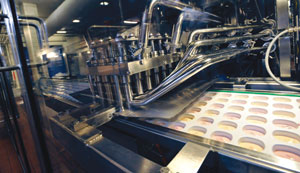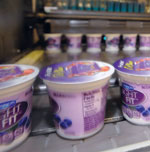
“People are starting to see that all these changes are bringing benefits. They are starting to believe our plan, and the results are showing.”
-- Didier Menu, plant director
-- Didier Menu, plant director

Using
cups thermoformed on-site is one of the biggest challenges at Minster.
The 336,000-square-foot plant produces about 100 stock-keeping units (SKUs), including Dannon’s flagship yogurt, DanActive drinkable yogurt, the children’s drink Danimals and the new probiotic products, Activia yogurt and DanActive beverages. It’s the fourth-largest plant in the company and the biggest of the three in the U.S.
The Minster facility has been part of Dannon since the late 1960s. Its recent history has included a series of adaptations to Dannon’s strategies on packaging and other operational aspects. The plant has made (in some cases, is still making) these adaptations smoothly, while coping with the challenges familiar to any food packaging operation: ever-leaner operations, more sustainable packaging and greater shelf appeal.
The Minster plant forms the eastern wing of an upside-down triangle of Dannon facilities in the U.S., the other two being in Fort Worth, Texas, and West Jordan, Utah. Until recently, Minster had specialized in spoonable yogurt alone, leaving the beverages to Fort Worth. But with Dannon’s products having an average shelf life of 40 to 50 days, the company decided to distribute the product portfolio more evenly across all three plants, making them in effect regional producers. This meant Minster had to start processing DanActive and the other beverages, which required shifting around some lines and reducing their footprint.
Another challenge came in the form of a basic packaging change. About three years ago, Dannon began phasing out preformed cups for its smallest single-serve yogurt SKUs. In-plant thermoforming saves Dannon in transportation costs and storage space, and increases production flexibility. The in-mold labels used in thermoforming help provide this flexibility, while improving shelf appearance.
It’s a gradual process that is still ongoing. Eventually, Dannon plans to have 100% of its small single-serve yogurts in thermoformed cups. “It is likely that several [more] preformed cup machines are going to be replaced [in 2009] by thermoformed machines,” says plant director Didier Menu.
Getting the staff on board with the change has been one of the major challenges, Menu says: “People are starting to see that all these changes are bringing benefits. They are starting to believe our plan, and the results are showing.”
Progress is already visible through performance indicators, which capture the production facility’s ability to operate more effectively and productively. Efficiency has increased over the last year, and this improvement will place the Minster site amongst the best in absolute improvements when compared to the forty-plus Danone dairy plants worldwide.
Thermoformed cups also have two important environmental advantages. Their walls are about 25% thinner than preformed ones, and they are easier to transport, lowering the plant’s overall “carbon footprint.”
Another environmental initiative that got Dannon a lot of attention was its decision, about four years ago, to stop using overcaps for its 6-ounce yogurt, relying for protection on the upper foil liner. This made things slightly easier on the packaging line. With overcaps, the heat sealer had a narrow temperature range. If it was too hot, the container’s rim would expand and make it hard to fit the cap; not hot enough, and the rim’s expansion was inadequate, leaving the overcap loose and liable to fall off. It also allowed Dannon to make its cases a little smaller, saving on corrugated (and improving the carbon footprint).
For high-density polyethylene (HDPE) bottles, the plant uses another form of on-site efficiency. It has a “through-the-wall” arrangement with Graham Packaging, which leases and operates a facility on the Minster site. The arrangement ensures Dannon a steady supply of beverage bottles at Minster, without having the hassle and expense of transporting and storing them.

Dannon
decided to do without overcaps on 6-ounce yogurt cups, which not only saved
plastic but makes sealing at Minster and other plants a little easier.
People involvement
To gauge progress on the plant floor, Dannon uses a formula it calls QCDM: quality, cost, delivery and motivation. The plant ties these concepts to specific metrics and posts the results, for each line, in the plant’s hallways. Quality translates to the amount of product removed from each line per shift; cost, to production efficiency (actual production divided by maximum throughput).One of the ways to drive down costs and increase efficiencies is to get packaging lines down to one person, or one and a half max, between the filler and the palletizer. This is a challenge that spreads across the plant and engages workers on the lines that are still using preformed cups, Menu says.
“One of the benefits…is that these new [thermoforming] machines have created a dynamic of improvement on the old machines, on the old lines. And that’s good for the site,” he says. “Otherwise, people working on the old lines could have felt a bit left behind.” So far, five of the 12 packaging lines are down to one-person operation.
Another significant upgrade to the Dannon facility is a new utility building, which is scheduled to come on line in March. The boilers, air compressors and other equipment in the new building replace equipment that was 20 years old and, in some cases, at the limit of its capacity. The new utility equipment may save up to 10% in energy costs.
With all the changes going on, Minster management has to make sure workers aren’t left behind.
“The next challenge is people involvement, because the vision is clear, we’ve explained it,” Menu says. “But to get it in fact, in the everyday life [of the workers], it takes a long time. Yes, the concept is clear. Yes, we have started. But before it is 100% effective, it takes a long time. So we are investing significantly in people in training, for example, but as well, ways of getting people involved like what we call problem-solving groups.” For example, “zoning” groups solicit feedback from operators as to the best layout of their workstations for tools, monitors and other equipment.
The three most important aspects of plant operations, according to Menu: “People involvement, people involvement, people involvement.”
Graham Packaging
717-849-8500;www.grahampackaging.com
At-A-Glance
Company:DannonLocation:Minster, Ohio
Size:336,000 square feet
Products:Dannon yogurt, DanActive, Activia, Danimals, other spoonable and drinkable yogurt
Packaging:PP cups, HDPE bottles
No. of packaging lines:12
